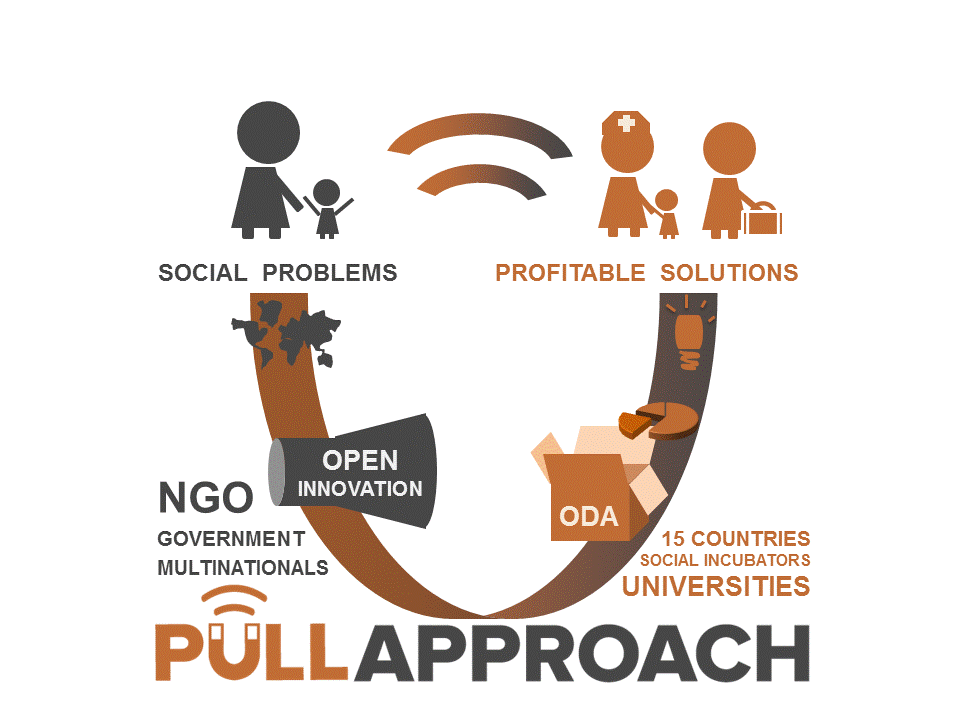 Notes From The Field: Nikon Rasumov, co-founder of Pullapproach outlines a route to data collection with lower transaction costs and, thus, a shorter route to impact for social enterprises.
Notes From The Field: Nikon Rasumov, co-founder of Pullapproach outlines a route to data collection with lower transaction costs and, thus, a shorter route to impact for social enterprises.
…
The father of Corporate Social Responsibility (CSR), R.E. Freeman, argued almost 30 years ago that all for-profits should consider their impact on regional stakeholders. While such CSR programs are traditionally assumed by larger organizations, the advent of technology has made it possible for all businesses to identify their innate social fiber at minimal cost.
In a complementary trend, nonprofits are beginning to incorporate profitable business models into their daily operations to ensure a truly lasting impact. Both for-profits and non-profits are converging towards profitable business models with measurable social impact (i.e. social enterprises).
Identifying and scaling social enterprises
Social enterprises (SE) range from ridesharing websites to low-cost fitness centers for underserved communities. They are financed through various revenue streams and are at the forefront of business model innovation. Their success in complementing the traditional grant-based approaches used by governments and NGOs has incited a demand to identify and scale SE.
At Pullapproach we use a two-stage approach to identify and scale social enterprises. First, we offer online business tools needed by social incubators and universities to measure and foster SE. Second, we offer open innovation technology to regional agencies to define and then implement selected social enterprises. Combining the two steps allows us to identify and scale existing SE to a new region. For example, in the first stage, an energy startup, like Efizity, would begin to use our platform through our partnership with a social incubator in Chile. In the second stage, using our open innovation technology, citizens vote for the enterprise that best resolves their local problems. In this way, governments outside of Chile can use our technology to implement the best available solution to address local problems like energy shortages. How could you identify successful social enterprises?
High cost of traditional data acquisition
So far, the traditional method of identifying the most promising social enterprises utilizes questionnaires to compare social and financial impact. Leading organizations have pioneered efforts to measure and to benchmark social impact. One impact and reporting standard, IRIS, co-developed by the Rockefeller Foundation and Acumen Fund, takes into account more than 300 dimensions to gauge impacts, from child mortality to CO2 emission. Other organizations, like GIIRS, offer accreditation, in two-year intervals, for adhering to social governance norms. New legal frameworks for incorporating stakeholders have recently been established in California as benefit corporations and financial reporting tools are complemented by social impact assessment tools like Pulse.
However, the transaction cost for providing complete data through social impact questionnaires is still too high, relative to its added value. As a result, traditional data acquisition is infrequent and hinders wide range adoption of even free social measurement tools.
Organic Data Acquisition lowers transaction cost
An alternative social and financial reporting strategy is organic data acquisition (ODA), which accumulates data with a minimal transaction cost. ODA begins with intelligent process design because any data acquisition depends on the willingness of the user to provide data. Incorporating pioneering design elements is becoming increasingly important since it is unfeasible to track 300 social impact variables in real time through pages of questionnaires.
At Pullapproach we use ODA to lower reporting barriers by creating an online platform where social incubators and universities can foster their social enterprises. Simultaneously, our technology works in the background to generate reports on each enterprise’s financial status, social impact, local challenges, and risk. Pullapproach does this by integrating sophisticated back-end infrastructure with a user-friendly front-end interface. Utilizing these tools, Pullapproach has accumulated a database of more than 10,000 profitable solutions to social problems with an unprecedented detail of information.
Ironically, the prerequisite to this openness is privacy. The above information is protected by various privacy layers and is released only when the social enterprise chooses to communicate to mentors, investors, colleagues and the general public in order to benefit from available advice, funding, marketing and human capital.
The resulting customized and automated reporting allows for real-time benchmarking and tracking of social enterprises. A version of our technology is currently used by Wayra, Telefonica’s incubator network operating in more than 13 countries. Our risk analysis tool tracks all the current risks an enterprise faces and the tasks to address them. The Customer Relationship Manager enables companies to manage clients, send email campaigns to thousands of potential users and track results. The financial tools can be used to monitor the cost allocations. Pullapproach uses this range of detailed and dynamic information to identify profitable business models and to define their social impact. What else can You do with this data?
Predicting the success of social enterprises
Apart from identifying successful social enterprises, there are two other fundamental reasons to accumulate this data organically: the curse of dimensionality and the power of predictive algorithms. Adding 300 dimensions of social impact results in a theoretical problem called the curse of dimensionality, which requires an exponential increase in sample size as dimensions increase in order to detect significant trends. In other words, to learn from programs that address social and environmental impact, no institution can be an island to itself and, instead, needs to pool data in order to detect trends beyond simple benchmarking.
Assuming this real-time, big-data flood, we will predict the impact of a social enterprise based on early indicators, similar to the work developed in online learning to detect promising school performance. The resulting opportunity for big testing of what works for social enterprises will facilitate the scaling and matching of profitable business models to the regions where they have the biggest growth perspective.
What is required to enable this?
Open Innovation to define the problem
One barrier for scaling successful social enterprises lies in the innate difficulty of defining the social problem. Open Innovation platforms advanced by OpenIdeo and Challenge.gov encourage opinion and information flow amongst regional stakeholders. An NGO in Latin America recently used Pullapproach’s own Open Innovation technology to engage citizens, students, entrepreneurs, and local experts. More than 20,000 citizens commented on the most promising social enterprises and suggested ways to improve the local community.
In the future, these platforms will enable community members to interact with social problems by offering financial contributions, human capital or advice. Ultimately, thanks to Twitter standards and Google developments in natural language processing, regional stakeholders will be able to define problems in casual conversations. Going beyond problem definition, citizens and governments will close the loop of ODA and Open Innovation. Using our vast database of social enterprises, regional agencies will franchise successful business models from other countries instead of reinventing the wheel.
Pullapproach: matching problems with solutions
In this respect, the social sector is undergoing an historic revolution by adapting technology and financial frameworks that define social problems and identify profitable solutions. The unique combination of Open Innovation technology and ODA will match the most promising social enterprises with the most acute regional problems and might indeed cause a singularity in the social sector.
